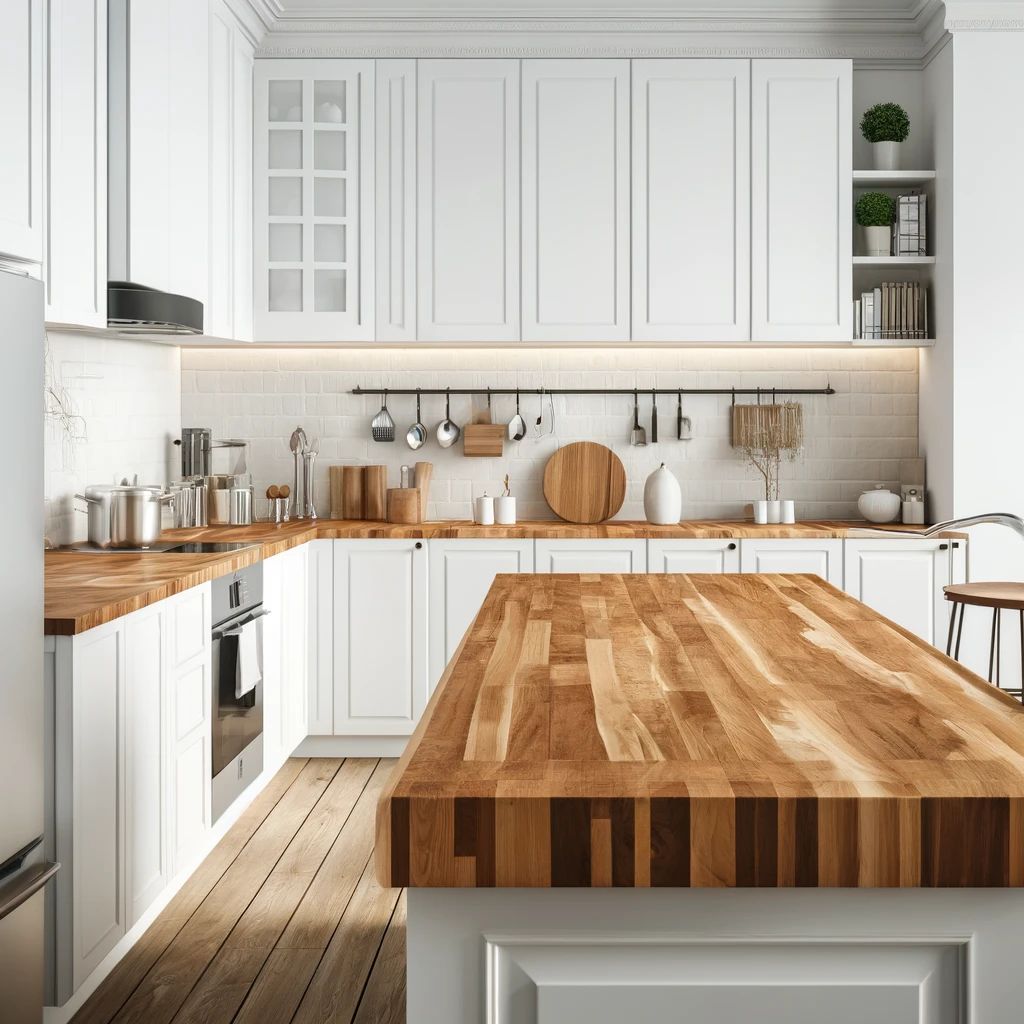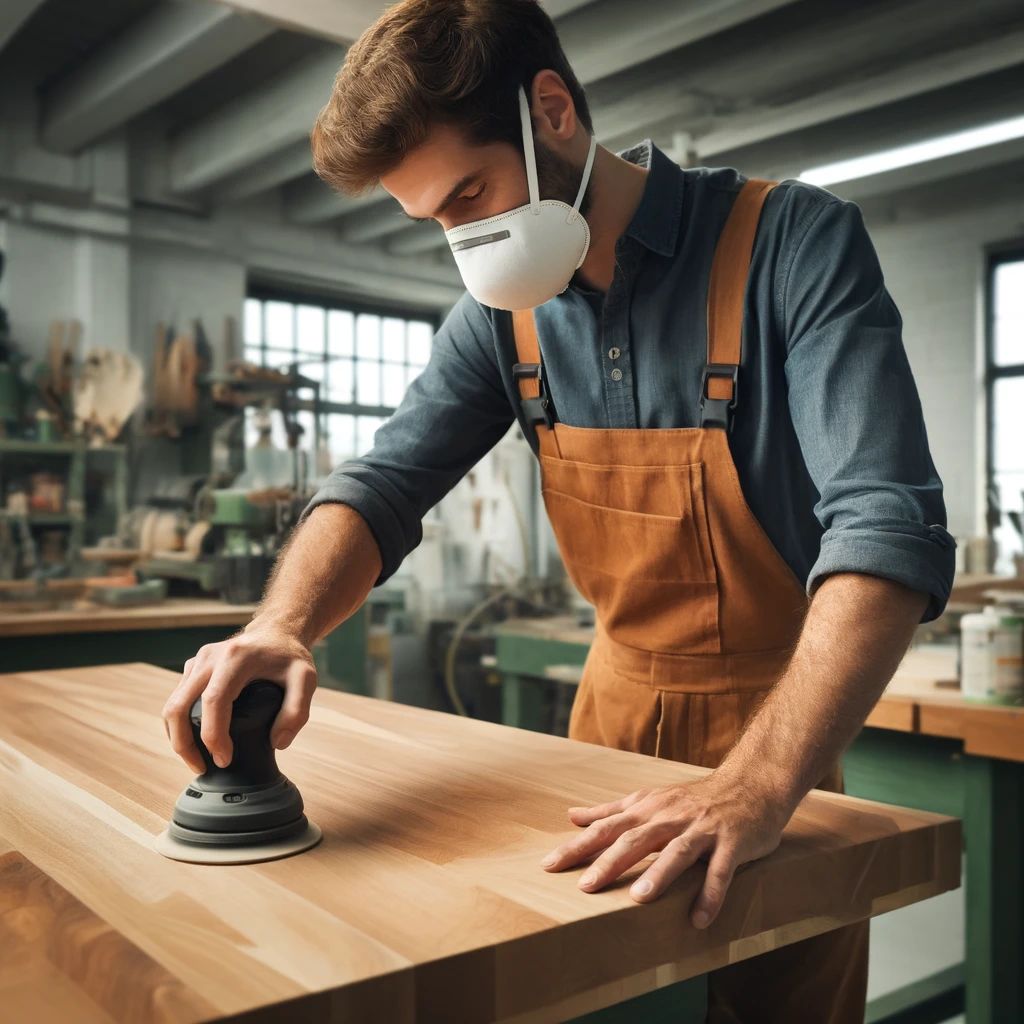
Key Takeaways
- Refinishing butcher block countertops can be done DIY with the right tools and techniques.
- Preparation is key — cleaning and sanding are essential steps before applying any new finish.
- Choosing the right finish will protect your countertop and enhance its natural beauty.
- Regular maintenance, including cleaning and oiling, will extend the life of your butcher block.
- With patience and care, you can transform and preserve your butcher block countertops for years to come.
Revitalize Your Kitchen with a Butcher Block Makeover
Butcher block countertops are a timeless addition to any kitchen, offering warmth, functionality, and style. Over time, though, they can become worn and dull. Don’t worry; with a little elbow grease and some know-how, you can bring them back to life! Let’s dive into the transformative process of refinishing your butcher block countertops.
Transforming Your Butcher Block Countertops
First things first, let’s talk about what you’ll be doing. Refinishing your butcher block involves several steps: cleaning, sanding, and applying a new finish. Each step is essential to achieving that brand-new look. Whether your butcher block has minor scratches or deep cuts, we’ll cover how to tackle them all.
Remember, the goal is not just to make it look good for now, but to ensure it stands up to the rigors of kitchen use. So, we’re not just talking about a quick fix; we’re talking about a full-blown countertop revival.
Giving Your Butcher Block a Second Chance
Why refinish instead of replace? Because it’s not only cost-effective but also incredibly satisfying to see the fruits of your labor every time you step into your kitchen. And with refinishing, you have the opportunity to customize the finish to your liking, whether you prefer a matte look or a glossy sheen.
Tools and Supplies You’ll Need
To get started, you’ll need to gather your materials. Here’s a basic list:
- An electric orbital sander or sanding blocks if you’re going manual
- Sandpaper in various grits (start with 60 grit and work up to at least 150 grit)
- A good quality wood cleaner
- Wood conditioner or mineral oil for finishing
- Clean rags for wiping down the surface
- A shop vac or a good old-fashioned dustpan and brush to clean up the sawdust
- Protective gear like gloves and a dust mask
With these tools at the ready, you’re set to start the process of bringing your butcher block back to its former glory.

DIY Butcher Block Kitchen Countertop Refinishing Steps
Refinishing butcher block countertops can breathe new life into your kitchen or workspace. Here are the general steps involved:
Step 1: Preparing the Surface
The first step is to make sure your countertop is clean. Any dirt or residue left on the surface can interfere with the refinishing process. Use a quality wood cleaner and a non-abrasive scrub pad to remove any grime. Then, wipe the surface down with a damp cloth and allow it to dry completely.
Step 2: Sanding
Before you begin sanding, take a good look at your countertop. Assess the damage. Are there deep cuts, or is the surface just a little dull? This will determine how much sanding you’ll need to do and which grit of sandpaper you should start with.
- If the surface is fairly intact, you might start with a medium grit like 100.
- For more serious damage, begin with a coarse grit like 60 to smooth out the rough edges.
Remember, the goal is to create a smooth, even surface for your new finish to adhere to. So, take your time and be thorough.
The Technique: Sanding Evenly and Safely
Once you’ve determined the starting grit, it’s time to sand. Always sand in the direction of the wood grain to prevent scratches that can be accentuated by the finish. If you’re using an orbital sander, keep it moving at all times to avoid creating dips or uneven surfaces. Sand the entire surface evenly, progressing to finer grits until you achieve a smooth finish. Typically, you’ll move from 60 to 80, then 120, and finish with 150 grit or higher for a silky feel.
After sanding, wipe down the countertops with a damp cloth to remove any dust or debris. Allow them to dry completely.
No Sanding Tool? No Problem!
If you don’t have a power sander, don’t fret. Manual sanding with sanding blocks or sheets can be just as effective, although it requires more time and effort. The key is to maintain consistent pressure and cover the entire surface. It’s a workout, but the payoff is a countertop that looks and feels custom-crafted by your own hands.
Step 3: Choosing Your Finish
After sanding, you’ll need to choose a finish. There are several options, each with its own set of benefits. You could go with a food-safe mineral oil, a blend of oil and wax, or a more durable water-resistant finish like polyurethane or lacquer. Consider your kitchen’s activity level and the look you want to achieve. A mineral oil finish is easy to maintain and gives a natural look, while polyurethane provides a tougher surface.
Whatever you choose, make sure it’s food-safe if you plan to prep food directly on the countertop. Also, think about the maintenance commitment. Some finishes require more frequent touch-ups than others.
Now that you’ve picked your finish, it’s time to apply it. But before you do, make sure to remove all the dust from sanding. A tack cloth is perfect for this job, as it picks up even the finest dust particles.
Oiling for a Natural Look
If you’ve decided on oiling, you’re in for a treat. Oiling brings out the natural colors and patterns of the wood, and it’s quite simple to do. You’ll need a clean rag and food-safe mineral oil or a specially formulated butcher block oil. Apply the oil liberally, working it into the wood in the direction of the grain. Allow it to soak in for a few minutes before wiping off the excess.
Here’s a tip: Warm the oil slightly before applying. It’ll penetrate the wood more deeply, offering better protection.
After the initial oiling, wait for it to dry, which may take a few hours to overnight. You’ll likely need to apply several coats for the best protection, especially if the wood was very dry to begin with. Between coats, give it some time to absorb the oil fully.
The Art of Oil Application
When applying oil, less is more. You want to apply thin, even coats rather than drenching the wood. After each coat, buff it gently with a clean, dry cloth to help the oil absorb and remove any surface stickiness. The oil not only protects the wood but also helps to hide small imperfections and scratches, giving your countertop a refreshed look.
Polyurethane Finish
If you’re using a sealant like polyurethane for a more durable finish, the application is a bit different. First, choose a product that’s food-safe once cured. Apply the sealant with a fine-bristle brush or foam brush, working in long, even strokes with the grain. Avoid overworking the finish to prevent bubbles and brush marks
Eco-Friendly Options
For those concerned about the environment and health, there are eco-friendly sealants available. These water-based options have low VOCs (Volatile Organic Compounds) and are less toxic. They dry quickly and can provide a durable, non-yellowing finish that’s safe for food contact after curing.
Whether you choose an oil-based or water-based polyurethane, read the manufacturer’s instructions carefully. Each product has specific application methods and drying times that you’ll need to follow for the best results.
Mastering the Polyurethane Technique
Applying polyurethane can be tricky, but here’s how to get it right:
- Stir the polyurethane gently to avoid creating bubbles.
- Use a tack cloth to remove all dust from sanding.
- Apply thin coats rather than one thick one to prevent drips and uneven areas.
- After the first coat dries, sand lightly with a very fine grit sandpaper (220 or higher) to remove any bumps or imperfections.
- Clean the surface again with a tack cloth before applying the next coat.
Usually, two to three coats of polyurethane are enough, but follow the product’s guidelines for the best finish.
Curing Time and Patience
After sealing, your butcher block needs time to cure. This can take anywhere from a few days to a week, depending on the product and the conditions in your home. Be patient and avoid using the countertop during this time. The longer it cures, the harder and more durable the finish will be.
Step 4: Buffing
Once you’ve applied the final coat of oil and it’s had time to dry, give your countertop a good buffing. This will help to even out the finish and bring up a soft sheen. Use a clean, soft cloth and work in circular motions, following the grain of the wood. This step also helps to remove any residual oil, ensuring the countertop isn’t greasy to the touch.

Maintenance for Longevity
Now that you’ve put all this work into your butcher block, you’ll want to keep it looking great. Here’s how to maintain it:
Regular Cleaning Habits
Keep your butcher block countertops in top shape by adopting some simple cleaning habits. Clean spills immediately to prevent staining and water damage. Use a soft cloth and a bit of mild dish soap for daily wipe-downs. If you need to disinfect, a solution of equal parts vinegar and water does the trick without harming the wood. Always dry the surface thoroughly after cleaning to prevent water damage.
Periodic Re-oiling Schedule
Maintaining your butcher block countertops is important to their longevity and aesthetic appeal. One key aspect of maintenance is establishing a periodic re-oiling schedule to keep the wood hydrated and protected from wear and tear.
Re-oiling is like giving your countertops a spa treatment. It hydrates the wood and keeps it from drying out and cracking. How often you need to re-oil depends on how much wear and tear your countertops see. A good rule of thumb is every three to six months. If the wood starts to look dry or lighter in color, it’s time for an oil treatment.
When to Refinish Again
Butcher block countertops are durable, but they’re not indestructible. With time, you may notice the finish wearing thin or damage that oil can’t fix. When that happens, it’s time to refinish. Typically, a full refinish might be needed every few years, but keep an eye on the condition of your countertops and let that be your guide.
By following these steps and practicing regular maintenance, your butcher block countertop will remain a beautiful and functional part of your kitchen for years to come!

Frequently Asked Questions (FAQ)
How often should I re-oil my butcher block countertops?
Re-oiling frequency depends on usage and exposure to moisture. A general recommendation is to re-oil every three to six months, or whenever the wood looks dry. If you use your butcher block countertops daily, you might need to re-oil more frequently.
Can I cut directly on my refinished butcher block?
Yes, you can! That’s one of the beauties of butcher block. However, keep in mind that cutting directly on the surface will lead to scratches and knife marks over time. If you want to keep your countertops looking pristine, consider using a cutting board.
What’s the best finish for butcher block in high-moisture areas?
Choosing the best finish for your butcher block countertops in areas with high moisture is critical for maintaining their durability and aesthetic appeal. A water-resistant finish, such as polyurethane, is often recommended because it provides a strong barrier against moisture and wear. It’s important to select a polyurethane product that is food-safe once cured, especially if you plan to prepare food directly on the surface. While oil finishes may offer a more natural look and are easier to reapply, they are less resistant to moisture. However, frequent reapplication of oil can help maintain its protective properties and keep the wood conditioned.
Is it safe to refinish butcher block countertops myself?
Absolutely! With the right tools, materials, and a bit of patience, you can safely refinish your butcher block countertops. Always follow safety guidelines, such as wearing a dust mask while sanding and working in a well-ventilated area.
How do I repair deep cuts or gouges in my butcher block?
For deep cuts or gouges, you can use wood filler that matches the color of your butcher block. Apply the filler, let it dry, then sand it down flush with the surface. Finish by re-oiling or resealing the countertop to protect the repair.





Leave a Reply